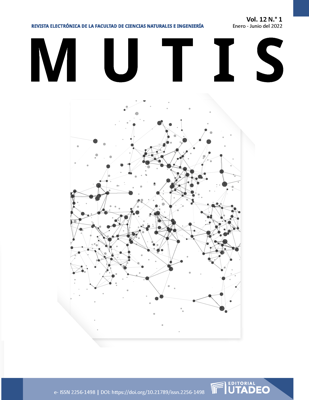
Esta obra está bajo una licencia internacional Creative Commons Atribución-NoComercial-CompartirIgual 4.0.
Esta obra está bajo una licencia internacional Creative Commons Atribución-NoComercial-CompartirIgual 4.0.
Resumen
El aumento poblacional ha creado una mayor demanda en la producción de alimentos en el ámbito mundial, por lo cual la agricultura es uno de los sectores más representativos, al tiempo que proporciona equilibrio al sistema económico dado su aporte al pib mundial por la generación de diferentes productos agrícolas. Sin embargo, el desarrollo de prácticas productivas extensivas en busca de mejorar la productividad ha promovido la utilización excesiva de insumos químicos y causado problemas ambientales como eutrofización de fuentes hídricas, acidificación del suelo, disminución de biodiversidad o emisión de gases de efecto invernadero. Por ello, el gran desafío es proporcionar seguridad alimentaria sin afectar la sostenibilidad ambiental. El desarrollo de agricultura sostenible requiere reducción del uso de agroquímicos y reemplazo por productos o procesos más ecológicos, eficientes y económicos; contexto en el que se ha promovido el uso de biofertilizantes teniendo en cuenta la dinámica e importancia de las comunidades microbianas del suelo, así como sus funciones benéficas y cooperativas en la productividad agrícola. Este artículo presenta una revisión acerca del uso de fertilizantes, la contaminación ambiental en agroecosistemas, los biofertilizantes y las propiedades de algunos microorganismos que sirven como base para su fabricación (fijadores de nitrógeno y solubilizadores de fosfato), al igual que los pasos generales del proceso de producción, de tal forma que se promueva el conocimiento de esta biotecnología para manejo de agroecosistemas. Hoy se están produciendo cambios respecto a las prácticas agrícolas y la producción de alimentos en busca de la sostenibilidad; por tal motivo, el estudio de procesos como fijación de nitrógeno molecular y solubilización de fosfatos constituye una base para mejorar la calidad de los insumos biológicos.
Citas
Alfonso, E., Leyva, A. y Hernández, A. (2005). Microorganismos benéficos como biofertilizantes eficientes para el cultivo del tomate (Lycopersicon esculentum, Mill). Rev. Colomb. Biotecnol, 2(2), 47-54.
Antoun, H., Beauchamp, C., Goussard, N., Chabot, R. y Lalande, R. (1998). Potential of Rhizobium and Bradyrhizobium species as plant growth promoting rhizobacteria on non-legumes: effect on radishes (Raphanus sativus L.). Plant Soil, 204, 57-67. https://doi.org/10.1023/A:1004326910584
APHA (2002). Standard Methods for the Examination of Water and Wastewater. Washington: American Public Health Association.
Atlas, R. y Bartha, R. (2002). Ecología microbiana y microbiología ambiental. Madrid: Pearson.
Baldani, J., Caruso, L., Baldani, V., Goi, S. y Döbereiner, J. (1997). Recent advances in BNF with non-legume plants. Soil Biology and Biochemistry, 29(5-6), 911-922. https://doi.org/10.1016/S0038-0717(96)00218-0
Barabasz, W., Albińska, D., Jaśkowska, M. y Lipiec, J. (2002) Biological effects of mineral nitrogen fertilization on soil microorganisms. Polish Journal of Environmental Studies, 11(3), 193-198.
Beltrán, M. (2014). La solubilización de fosfatos como estrategia microbiana para promover el crecimiento vegetal. Corpoica Cienc. Tecnol. Agropecu, 15(1), 101-113. https://doi.org/10.21930/rcta.vol15_num1_art:401
Bhattacharyya, P. y Jha, D. (2012) Plant growth-promoting-rhizobacteria (PGPR): emergence in agriculture. World J. Microbiol Biotechnol., 28, 1327-1350. https://doi.org/10.1007/s11274-011-0979-9
Caballero, J. (2006). Microbiología agrícola e interacciones microbianas con plantas. Revista Latinoamericana de Microbiología, 48(2), 154-161.
Çakmakçi, R., Dönmez, F., Aydın, A. y Şahin, F. (2006). Growth promotion of plants by plant growth-promoting rhizobacteria under greenhouse and two different field soil conditions. Soil Biol. Biochem., 38(6), 1482-1487. https://doi.org/10.1016/j.soilbio.2005.09.019
Calabi-Floody, M., Medina, J., Rumpel, C., Condron, L., Hernández, M., Dumont, M. y De la Luz, M. (2018). Smart Fertilizers as a Strategy for Sustainable Agriculture. Advances in Agronomy, 147, 119-157. https://doi.org/10.1016/bs.agron.2017.10.003
Castilla, L. (2006). Fertilización bio-orgánica en el cultivo del arroz. En L. Castilla y M. Bolaños (Eds.), La biofertilización: una alternativa viable para la nutrición vegetal. Ibagué: Sociedad Colombiana de la Ciencia del Suelo.
Chabot, R., Beauchamp, C., Kloepper, J. y Antoun, H. (1998). Effect of phosphorus on root colonization and growth promotion of maize by bioluminescent mutants of phosphate-solubilizing Rhizobium leguminosarum biovar phaseoli. Soil Biol. Biochem., 30(12), 1615-1618. https://doi.org/10.1016/S0038-0717(98)00054-6
Chen, Y., Rekha, P., Arun, A., Shen, F., Lai, W. y Young, C. (2006). Phosphate solubilizing bacteria from subtropical soil and their tricalcium phosphate solubilizing abilities. Appl. Soil. Ecol., 34(1), 33- 41. https://doi.org/10.1016/j.apsoil.2005.12.002
Chirinos, J., Leal, A. y Montilla, J. (2006). Uso de insumos biológicos como alternativa para la agricultura sostenible en la zona sur del estado Anzoátegui. Revista Digital Ceniap Hoy, 11. https://ingenieriadereacciones.files.wordpress.com/2013/02/5-zona-sur-de-anzoatgui-bioprodctos.pdf
Compant, S., Brion, D., Jerzy, N., Christophe, C. y Essaïd, A. (2005). Use of plant growth-promoting bacteria for biocontrol of plant diseases: principles, mechanisms of action and future prospects. Appl. Environ. Microbiol., 71(9), 4951-4959. https://doi.org/10.1128/AEM.71.9.4951–4959.2005
Coyne, M (2000). Microbiología del suelo. Un enfoque exploratorio. Madrid: Paraninfo.
De López, L., De Míguez, S. y Marbh, L. (1997). Heavy metals input with phosphate fertilizers used in Argentina. The Science of the Total Environment, 204(3), 245-250. https://doi.org/10.1016/S0048-9697(97)00187-3
Delgadillo, R., Virgen, G., Tabares, S. y Olalde, V. (2001). Bacterias promotoras del crecimiento de plantas: agro-biotecnología. Avance y Perspectiva, 20, 395-400.
Dobereiner, J., Baldani, V. y Baldani, J. (1995). Como isolar e identificar bacterias diazotróficas de plantas na᷉o-leguminosas. Embrapa-Spi, Brazil.
El Mujtar, V., Muñoz, N., Mc. Cormick, B., Pulleman, M. y Tittonell, P. (2019). Role and management of soil biodiversity for food security and nutrition; where do we stand? Global Food Security, 20, 132-144. https://doi.org/10.1016/j.gfs.2019.01.007
Himani, M. y Siddhardha, B. (2019). Use of microbial biofertilizers technology in agro-environmental sustainability. En New and Future Developments in Microbial Biotechnology and Bioengineering (pp. 199-211). https://doi.org/10.1016/B978-0-12-818258-1.00013-3
Hurek, T., Reinhold-Hurek, B., Van Montagu, M. y Kellenberger, E. (1994). Root colonization and systemic spreading of Azoarcus sp. Strain BH72 in grasses. Journal of Bacteriology, 176(7), 1913-1923. https://doi.org/10.1128/jb.176.7.1913-1923.1994
Hynes, R., Craig, K., Covert, D., Smith, R. y Rennie, S. (1995). Liquid rhizobial inoculants for lentil and field pea. J. Prod. Agric., 8(4), 547-552. https://doi.org/10.2134/jpa1995.0547
Kanimozhi, K. y Panneerselvam, A. (2010). Studies on isolation and nitrogen fixation ability of Azospirillum spp.isolated from Thanjavur district. Der Chemica Sinica, 1(3), 138-145.
Kellman, L. y Hillaire-Marcel, C. (2003). Evaluation of nitrogen isotopes as indicators of nitrate contamination sources in an agricultural watershed. Agriculture, Ecosystems and Environment, 95(1), 87-102. https://doi.org/10.1016/S0167-8809(02)00168-8
Kim, K., Jordan, D. y McDonald, G. (1998). Effect of phosphate solubilizing bacteria and vesicular–arbuscular mycorrhizae on tomato growth and soil microbial activity. Biol. Fertil. Soils, 26, 79-87. https://doi.org/10.1007/s003740050347
Kloepper, J., Lifshitz, R. y Zablotowicz, R. (1989). Free-living bacterial inocula for enhancing crop productivity. Trends Biotechnol., 7(2), 39-44. https://doi.org/10.1016/0167-7799(89)90057-7
Kumar, V. y Narula, N. (1999). Solubilization of inorganic phosphates and growth emergence of wheat as affected by Azotobacter chroococcum mutants. Biol. Fertil. Soils, 28, 301-305. https://doi.org/10.1007/s003740050497
Kundu, M., Mandal, B. y Hazra, G. (2009). Nitrate and fluoride contamination in groundwater of an intensively managed agroecosystem: A functional relationship. Science of the total environment, 407(8), 2771-2782. https://doi.org/10.1016/j.scitotenv.2008.12.048
Lapsansky, E. R., Milroy, A. M., Andales, M. J. y Vivanco, J. M. (2016). Soil memory as a potential mechanism for encouraging sustainable plant health and productivity. Current Opinion in Biotechnology, 38, 137-142. https://doi.org/10.1016/j.copbio.2016.01.014
Ledesma, C., Bonansea, M., Rodríguez, C. y Sánchez, A. (2013). Determinación de indicadores de eutrofización en el embalse Río Tercero, Córdoba (Argentina). Revista Ciência Agronômica, 44(3), 419-425. http://dx.doi.org/10.1590/S1806-66902013000300002
Legget, M. y Steckler, S. (2007). Microorganisms mediating an increase in phosphate availability to the plant – How to find and select microorganisms to use in a phosphate inoculant. Segundo curso internacional: “Microorganismos promotores del crecimiento vegetal: rizobacterias y solubilizadores o movilizadores de fosfato”. 24-28 de septiembre de 2007, Universidad Nacional de Colombia.
Mehrvarz, S. y Chaichi, M. (2008). Effect of phosphate solubilizing microorganisms and phosphorus chemical fertilizer on forage and grain quality of barely (Hordeum vulgare L.). American-Eurasian J. Agric. & Environ. Sci., 3(6), 855-860.
Moreno, R., García, T., Storch, J., Muñoz, M., Yáñez, E. y Pérez, E. (2011). Fertilización y corrección edáfica de suelos agrícolas con productos orgánicos. Tecnologí@ y Desarrollo, 9. https://revistas.uax.es/index.php/tec_des/article/view/571/527
Nautiyal, C. (1999). An efficient microbiological growth medium for screening phosphate-solubilizing microorganisms. FEMS Microbiology Letters, 170(1), 265-270. https://doi.org/10.1111/j.1574-6968.1999.tb13383.x
Nziguheba, G. y Smolders, E. (2008). Inputs of trace elements in agricultural soils via phosphate fertilizers in European countries. Sci. Total. Environ., 390(1), 53-57. https://doi.org/10.1016/j.scitotenv.2007.09.031
Pérez, E., Sulbaran, M., Ball, M. Y Yarzabal, L. (2007). Isolation and characterization of mineral phosphate-solubilizing bacteria naturally colonizing a limonitic crust in the south-eastern Venezuelan region. Soil Biology & Biochemistry, 39(11), 2905-2914. https://doi.org/10.1016/j.soilbio.2007.06.017
Pikovskaya, R. (1948). Mobilization of phosphorus in soil with connection with the vital activity of some microbial species. Mikrobiologiya, 17, 362-370.
Piotrowski, J. & Rillig, M. (2008). Succession of Arbuscular Mycorrhizal Fungi: Patterns, Causes, and Considerations for Organic Agriculture. Advances in Agronomy, 97, 111-130. https://doi.org/10.1016/S0065-2113(07)00003-X
Riggs, J., Chelius, M., Iniguez, A., Kaeppler, S. Y Triplett, E. (2001). Enhanced maize productivity by inoculation with diazotrophic bacteria. Aust. J. Plant Physiol., 28(9), 829-836. https://doi.org/10.1071/PP01045
Rosas, S., Rovera, M. Y Correa, J. (2006). Phosphate-solubilizing Pseudomonas putida can influence the rhizobia–legume symbiosis. Soil Biology & Biochemistry, 38(12), 3502-3505. https://doi.org/10.1016/j.soilbio.2006.05.008
Sánchez, X., Melgarejo, L., Vanegas, J., Sosa, T. y Fuentes, C. (2006). Diazótrofos de vida libre: perspectivas de aplicación. En L. Castilla y M. Bolaños (Eds.), La biofertilización: una alternativa viable para la nutrición vegetal. Bogotá: Sociedad Colombiana de la Ciencia del Suelo.
Santillana, N. (2006). Producción de biofertilizantes utilizando Pseudomonas sp. Ecología Aplicada, 5(1,2), 87-91. https://doi.org/10.21704/rea.v5i1-2.322
Shankar, J., Chandra, V. y Singh, D. (2011). Efficient soil microorganisms: A new dimension for sustainable agriculture and environmental development. Agriculture, Ecosystems & Environment, 140(3-4), 339-353. https://doi.org/10.1016/j.agee.2011.01.017
Smith, R., Alexander, R. y Wolman, M. (1987). Water-quality trends in the nation’s rivers. Science, 235, 1607-1615. https://doi.org/10.1126/science.235.4796.1607
Stefan, M., Dunca, S., Olteanu, Z., Oprica, L., Ungureanu, E., Hritcu, L., Mihasan, M. y Cojocaru, D. (2010). Soybean (Glycine max [L] Merr.) Inoculation with Bacillus pumilus RS3 promotes plant growth and increases seed protein yield: relevance for environmentally-friendly agricultural applications. Carpathian Journal of Earth and Environmental Sciences, 5(1), 131-138.
Stephens, J. y Rask, H. (2000). Inoculant production and formulation. Field Crops Research, 65(2-3), 249-258. https://doi.org/10.1016/S0378-4290(99)00090-8
Sttenhoudt, O. y Vanderleyden, J. (2000). Azospirillum, a free living nitrogen-fixing bacterium closely associated with grasses: genetic, biochemical and ecological aspects. FEMS Microbiology Reviews, 24(4), 487-506. https://doi.org/10.1111/j.1574-6976.2000.tb00552.x
Sundara, R. y Sinha, M. (1963). Phosphate dissolving organisms in the soil and the rizosphere. Indian J. Agr. Sci., 33, 272-278.
Takeda, A., Tsukada, H., Takakop, Y., Hisamatsu, S. y Nanzyo, M. (2006). Accumulation of uranium derived from long-term fertilizer applications in a cultivated Andisol. Science of the Total Environment, 367(2-3), 924-931. https://doi.org/10.1016/j.scitotenv.2006.01.006
Tiessen, H. & Stewart, J. (1985). The biochemistry of soil phosphorus. En D. Caldwell, J. Brierley, y C. Brierley (Eds.), Planetary Ecology. Nueva York: Van Nostraad Reinhold.
Uri, N. (1997). Incorporating the environmental consequences in the fertilizer use decision. Science of the Total Environment, 201(2), 99-111. https://doi.org/10.1016/S0048-9697(97)00088-0
Valero, N. (2003). Potencial biofertilizante de bacterias diazótrofas y solubilizadoras de fosfatos asociadas al cultivo de arroz (Oryza sativa L). [tesis de Maestría en Microbiología]. Bogotá: Universidad Nacional de Colombia.
Verzeaux, J., Hirel, B., Dubois, F., Lea, P. y Tétu, T. (2017). Agricultural practices to improve nitrogen use efficiency through the use of arbuscular mycorrhizae: Basic and agronomic aspects. Plant Science, 264(48-56). https://doi.org/10.1016/j.plantsci.2017.08.004
Vessey, J. (2003). Plant growth promoting rhizobacteria as biofertilizers. Plant and Soil, 255, 571-586. https://doi.org/10.1023/A:1026037216893
Yanni, G., Rizk, Y., El-Fattah, F., Squartini, A., Corich, V., Giacomini, A., De Bruijn, F., Rademaker, J., Maya-Flores, J., Ostrom, P., Vega-Hernandez, M., Hollingsworth, R., Martínez-Molina, E., Mateos, P., Velazquez, E., Wopereis, J., Triplett, E., Umali-Garcia, M., Anarna, J., Rolfe, B., Ladha, J., Hill. J., Mujoo, J., Perry, K. y Dazzo, F. (2001). The beneficial plant growth-promoting association of Rhizobium leguminosarum bv. Trifolii with rice roots Functional Plant Biology, 28, 845-870. https://doi.org/10.1071/PP01069
Descargas
Datos de publicación
Perfil evaluadores/as N/D
Declaraciones de autoría
- Sociedad académica
- Universidad de Bogotá Jorge Tadeo Lozano
- Editorial
- Universidad de Bogotá Jorge Tadeo Lozano

 PDF
PDF
 FLIP
FLIP
 XML
XML













